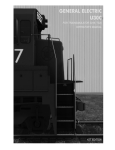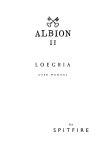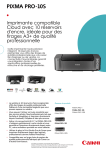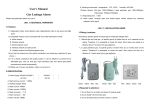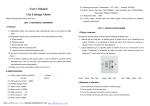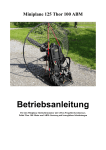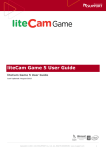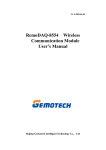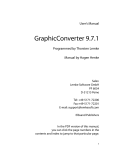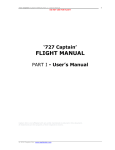Download user manual - Fastline Simulation
Transcript
(PRIVATE and not for Publication) F.S. 10061/5 fastline simulation HSA Scrap Wagons ex. HEA Coal Hoppers INSTRUCTIONS FOR USE OF A STOCK PACK FOR TRAIN SIMULATOR This book is for the use of customers, and supersedes as from 6th October, 2015, all previous instructions for the use of the above expansion pack for Train Simulator. THORNTON 6th OCTOBER, 2015 I. P. FREELY MOVEMENTS MANAGER order of contents Page Introduction... ... ... ... ... ... ... ... ... ... ... ... ... ... ... ... ... ... ... ... ... ... ... ... ... ... ... ... ... ... ... . 2 The Rolling Stock... . .. . .. . .. . .. . .. . .. . .. . .. . .. . .. . .. . .. . .. . .. . .. . .. . .. . .. . .. . .. . .. . .. . .. . .. . .. . .. . .. . .. . .. 2 File Naming Overview ... ... ... ... ... ... ... ... ... ... ... ... ... ... ... ... ... ... ... ... ... ... ... ... ... ... ... ... ... 5 Compromises... . .. . .. . .. . .. . .. . .. . .. . .. . .. . .. . .. . .. . .. . .. . .. . .. . .. . .. . .. . .. . .. . .. . .. . .. . .. . .. . .. . .. . .. . .. 6 Help and Support... . .. . .. . .. . .. . .. . .. . .. . .. . .. . .. . .. . .. . .. . .. . .. . .. . .. . .. . .. . .. . .. . .. . .. . .. . .. . .. . .. . .. . .. 6 More Information & Stay in Touch... ... ... ... ... ... ... ... ... ... ... ... ... ... ... ... ... ... ... ... ... ... ... ... ... ... 6 Thanks... . .. . .. . .. . .. . .. . .. . .. . .. . .. . .. . .. . .. . .. . .. . .. . .. . .. . .. . .. . .. . .. . .. . .. . .. . .. . .. . .. . .. . .. . .. . .. . .. 6 Bibliography... ... ... ... ... ... ... ... ... ... ... ... ... ... ... ... ... ... ... ... ... ... ... ... ... ... ... ... ... ... ... .. 7 Copyright ... . .. . .. . .. . .. . .. . .. . .. . .. . .. . .. . .. . .. . .. . .. . .. . .. . .. . .. . .. . .. . .. . .. . .. . .. . .. . .. . .. . .. . .. . .. . .. 7 Introduction This expansion is our sixth developed specifically for distribution via Steam Marketplace and follows on from our eight independently distributed rolling stock packs. This expansion features HSA Scrap Wagons in maroon and Railfreight flame red and grey liveries. The HSA wagons started out as HEA coal hoppers which were then converted for scrap traffic as the demand for industrial and house coal fell leaving surplus wagons available at the same time as scrap traffic was rapidly growing. The conversion itself was pretty straightforward with either a steel plate being welded over the hopper bottoms or the filling of the hopper bottoms with ballast as loading and unloading was achieved using grabs for magnets. The Rolling Stock In 1976 British Rail began the construction of nearly 2000 air braked 45t GLW coal hoppers to replace unfitted and vacuum braked wagons on flows of house and industrial coal where the receiving terminals were not equipped to deal with the HAA coal hoppers designed for merry-go-round work. The wagons were substantially constructed from steel with integral hoppers, supports and under-frames. Discharge was via four manually operated hopper doors. Early versions of the wagons had a centrally located access ladder at each end with thin supports at the corners of the hopper body. Somewhere in the range before No. 360242 this arrangement was modified to an offset ladder at the left hand side and no corner supports. The running gear as constructed featured weighing gear for a self adjusting brake system which utilised disc brakes. Initially the wagons were constructed with 13 leaf BR friction link suspension which allowed an maximum speed of 60 mph when loaded but only 45 mph when empty. Throughout the construction period a number of wagons were out shopped with experimental suspension systems, none of which were really successful. In 1979 the decision was taken to alter the suspension of the wagons to allow them to work at 60 mph irrespective of their loaded state. Consequently, Nos. 361782 - 361796 & 361799 were fitted with Bruninghaus suspension at the time of construction. Eventually all of the earlier wagons were re-sprung to match the latter built examples. The wagons appear to have been successful in the traffic they were designed for and could be seen across the network carrying a wide variety of different fuel types to local coal depots and other receiving points. However, the 1980s were not a good time for coal traffic as plentiful supplies of North Sea natural gas saw huge numbers of homes and businesses convert to gas for heating and manufacture. As a consequence a large number of hoppers were rebuilt or at least tried on other traffics with varying levels of success. One of the conversions which were attempted with the HEA hoppers from 1987 was for scrap traffic as there was a distinct shortage of wagons at the time. This shortage was possibly as a consequence of the removal of vacuum braked and unfitted trains from the network which meant that the 16T mineral wagons that had previously been used for scrap traffic were no longer available. It should also be remembered that at this time British Rail were actively encouraging customers to own or lease their wagons rather than them being supplied by the railway. With this situation in mind a very basic conversion of HEA hoppers was attempted for scrap traffic. The main aim of the conversion was to produce a flat bottomed wagon and to take the hoppers out of use as loading and unloading at scrap processors would be via mechanical grabs and magnets. This flat bottom was achieved in two ways, either a steel plate was welded across the bottoms of the hoppers at approximately under-frame height or a similar level of ballast was dropped into the wagon. The latter wagons can be identified by and increased tare weight that was patch painted on to the data panel. Although the idea was an admirable one to find use for assets that were sitting in sidings it appears safe to say that the use of the wagons for scrap traffic was not successful. Very rapidly the wagon bodies became seriously battered and damaged from the use of grabs and heavy magnets to load and unload them. This is not surprising when you compare the relatively light construction of the hoppers (designed to be loaded at the colliery from above and discharged through hoppers at the bottom) with the substantial private owner box wagons used for scrap traffic. Inevitably the end of Speedlink saw the end of the majority traffic for which the wagons had been converted but some do appear to have remained in use well into the 1990s. An HSA converted from an early build HEA hopper in weathered maroon livery. Judging by the lack of patch painting on the data panel this wagon was converted by welding a steel plate over the hoppers. This later build HEA managed to gain a coat of Railfreight flame red and grey livery before conversion to an HSA. The patch painted increased tare weight on the data panel would suggest this wagon has been converted by filling the hoppers with ballast. Rolling Stock Features This expansion contains HSA scrap wagons painted in maroon and Railfreight flame red and grey weathered liveries. Each of those versions is also supplemented loaded and empty versions with suitably modified physics to ensure a loaded train feels much different to an empty one. The expansion also contains a couple of more novel features. Body Switching As noted in the description of the rolling stock, approximately the first 240 HEA wagons were built with a central access ladder which was moved to the left hand side for the remainder of the build. A number of these early wagons found themselves converted to HSA hoppers.We have created this expansion to automatically switch the position of the ladder (based on the wagon number) and make a few other small changes to take in to account this variation of ladder location. Intelligent Tail Lamps Historically we have provided rear versions of our wagons fitted with a tail lamp as we felt that current solutions to automatically display a tail lamp didn’t really allow the control and versatility we desired. However, through some lateral thinking and perseverance we’ve finally come up with an automatically scripted solution which comes very close to the level of control we required. The key features of our ‘intelligent’ tail lamp are: ◊ layer services will display a lamp at the rear end and this will move up and down the train as vehicles are coupled/ P uncoupled. ◊ I services will display a lamp at rear and this should move up and down as vehicles are added or removed in A scenarios ◊ Loose consists will not display any lamps - including portions detached from Player and AI services ◊ L amps can be prevented from showing on any wagon by adding a N prefix to the vehicle number in the scenario editor either before or after the decal override if this is used ◊ L amps can be forced to appear in a similar manner by using a Y prefix. (If used with a single vehicle a lamp will appear at one end but the wagon may need to be rotated for the lamp to be where you want it). ◊ I services with a Service Class of ‘Special’ will not display a lamp and this needs to be forced to appear with a A prefix ◊ L oose consists are treated by Train Simulator as ‘Special’, if you wish a tail lamp to appear on one end (or indeed both ends) of such a consist you will need to force it to appear by adding a Y prefix to the relevant wagon(s). ◊ In a free roam scenario, selecting a consist with a Special type to become the player service will enable the lamps as per a normal service. In circumstances where the automatic display of a tail lamp is not desired, for example during shunting manoeuvres in a yard, adding a prefix of N to the vehicle number will prevent a tail lamp from being displayed on that vehicle. Conversely, if a tail lamp is required to be displayed and this does not happen automatically, for example a loose consist left in a siding, adding a prefix of Y will force a tail lamp to be displayed on the outer end of that wagon. Notes: ue to the way that the script executes when you add prefixes the results will not be shown until you save and D reload the scenario. Texture Switching Given the battering that the wagons received by grabs and magnets we have created three different textures for the Railfreight liveried version which are applied at random when placed in the game. This is not enabled for the maroon version as photographs suggest the battering was less apparent due to the darker overall colour. Tare and infill switching Given the two different methods of conversion the infill of the hopper bottoms, and where required, the associated tare weight patch have been randomised to appear as wagons are placed. Load Randomisation As wagons are not loaded in a nice neat and uniform way we have provided a number of different load shapes that are applied at random in the game to allow a little bit of variation down the train. Logo Randomisation There were at least five different styles of branding applied to (mainly) the Railfreight liveried wagons. These are available for the wagons and are applied randomly to all of the Railfreight liveried versions but also sparingly to the maroon ones. The logos can also be controlled using alphabetical prefix overrides as described below. Additionally, using a # as the prefix will prevent any logos from being displayed. Override prefix a : a361777 Override prefix b : b360545 Override prefix c : c361752 Override prefix d : d360849 Override prefix e : e361041 File Naming Overview We have developed a standardised naming structure for our rolling stock using the following mask: TOPS: LIVERY - FLAGS For example one wagon may be named HSA: RF W.E In effect this means it’s a HSA in Railfreight flame red and grey livery with weathered textures and empty physics. File name options The following is a list of the variable flags used in this pack: TOPS: HSA 45t GLW scrap wagon converted from HEA coal hopper LIVERY: M Maroon livery RF Railfreight flame red and grey livery FLAGS: E ‘Empty’ physics L ‘Loaded’ physics W Weathered/Dirty textured Compromises With any project you always have to make some compromises and this one has been no exception. We’re not ashamed of the ones we’ve made and we are more than happy to tell you about them. As noted above, early builds of the HEA hoppers had a central access ladder which then moved to an offset one at some point before wagon no. 360242. As it’s not exactly known when this change took place we have set the point in our detail switching script that all wagons before 360230 with have the central ladder. The actual HEA wagons that were converted changed considerably during the period of operation with the short life span of some of the hoppers in scrap traffic. As a result we have left all HEA numbers available in this expansion via the auto-numbering but naturally you can refine this in the simulator if you wish. In the same vein we have made all liveries available for wagons that may have carried them with the exception of the last build hopper numbers which will only appear on Railfreight liveried vehicles as the livery was introduced towards the end of the construction program. Help and Support General Issues with the Expansion In the unfortunate event that you find a problem or things won’t work we really do want to hear from you. Getting support is simple - all you need to do is send an e-mail to [email protected] and raise a support ticket about your issue and we’ll get back to you as soon as we can. Please don’t use Facebook, Twitter or the chat client etc as things are much more likely to be overlooked and more difficult to keep track of. Core Train Simulator Problems Although we are more than happy to investigate issues you may be experiencing with our expansions more general Train Simulator issues or observations should be directed to http://dovetailgames.kayako.com/ which is the location of the Dovetail Games Support Library and help desk. Steam Issues If the problem you are experiencing is related to a Steam purchase or download we will be unable to help you. The best course of action will be to take a look at the Steam Support pages which can be found here: https://support.steampowered.com/ More Information & Stay in Touch If you want to know more about what’s going on at fastline simulation there are a few things you can do. Website Our website can be found at www.fastline-simulation.co.uk and contains updates and information about all our present and future expansions. On the website you can also say hello via the chat client if it’s online if you’ve got a quick question to ask or drop us a line by emailing [email protected]. The Blog Our blog can be found at http://fastline-simulation.blogspot.com/ and is usually the place where in progress renders and screen shots appear along with little articles about other things that are going on. Twitter If you really want to know the tasks of the day or what’s really getting on our nerves you can follow our tweets at http://www. twitter.com/fastlinesim Facebook ‘Liking’ us on Facebook is probably the best way to go if you want to really keep your finger on the pulse, updates to the blog and website are fed in, all the Tweets appear as status messages and we even post extra pictures now and then with the added bonus that you get to comment too. Our page can be found at www.facebook.com/FastlineSimulation Mailing List Possibly one of the best ways of ensuring that you don’t miss out on any important announcements is to sign up for our mailing list.We only use the list for important expansion information, really special messages and occasionally to ask your opinion about things. We’ll never share your details with anyone else and you can easily unsubscribe at any time. To join the list please fill in the little box on this page: http://www.fastline-simulation.co.uk/index.php/manage-mailing-list Thanks The production of any product wouldn’t be possible without hard work, support and down right nagging. This pack is no exception and as such it’s only fair to say a big thank you to the families that allow us the time to do this/enjoy the fact we’re distracted and out of their hair for a bit! The other key element are the testers. It’s safe to say this is probably the best team of testers that’s been encountered for train simulation projects. They test thoroughly and speedily, communicate well, continually offer opinions and guidance and share the common aim to strive for quality. We should also thank the guys at Dovetail Games for putting up with us, humouring our wild ‘Is this possible?’ ideas and allowing the opportunity to create ‘official’ expansions! This is the eleventh expansion we’ve managed to get to the point of no return, (ok, release as we’re sick of the sight of it and releasing is the only way to stop the constant tinkering) so a big thank you should go to our family and friends for their patience and support with our playing trains! Bibliography Bartlett, P. HSA scrap carrying conversion HEA, in Paul Bartlett’s Photographs, 8 March 2012, viewed on 1 October 2015, http:// paulbartlett.zenfolio.com/hsa Copyright This manual and expansion contents are © Fastline Simulation Ltd. 2015. All trademarks are copyright of their respective owners. All rights reserved The contents of this pack may not be modified, reverse engineered, uploaded or redistributed without the written consent of Fastline Simulation Ltd with the exception of reskins of the models in line with the reskinning policy which is available from our website at www.fastline-simulation.co.uk












